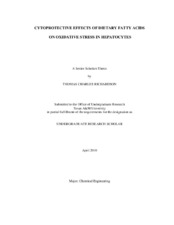| dc.description.abstract | Non-alcoholic fatty liver disease or NAFLD is characterized by the accumulation of fat
in the liver, also known as steatosis. This is one of the most common types of liver
diseases and can occur in a range of individuals. Once the liver is affected by steatosis,
the liver becomes more susceptible to more serious conditions such as non-alcoholic
steatohepatitis, cirrhosis, hepatocellular carcinoma, and liver failure. This research
focuses on studying the susceptibility of hepatocytes treated with various common
dietary fatty acids to subsequent inflammation and stress. Hepatocytes (HepG2 cell line)
were treated with oleic, linoleic and palmitic acid at different concentrations and
exposed to the pro-oxidant tert-butyl hydroperoxide (t-BHP) to induce oxidative stress.
The extent of cytoprotection by fatty acid pre-exposure was determined based on the
release of Lactate Dehydrogenase (LDH) into the supernatant from dead/dying cells.
After exposure, the cells were assayed for various markers of oxidative stress including
membrane integrity, lipid peroxidation, and protein carbonylation. Sodium Dodecyl
Sulfate Polyacrylamide Gel Electrophoresis (SDS-PAGE) was performed on the carbonylated proteins followed by commassie blue staining for visualization and
analysis. In general, samples with higher carbonyl content showed more intact proteins
on gels. Our analysis identified four specific bands which were present in samples from
cells untreated with t-BHP, as well as fatty acid treated cells. Such bands are most likely
proteins that are susceptible to degradation upon carbonylation. Identification of these
proteins by mass spectrometry will provide insights into the proteins susceptible to
oxidative stress during steatosis, as well as serve as likely biomarkers for complications
that arise from steatosis. | en |


